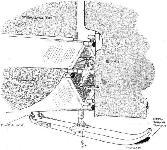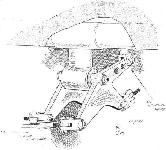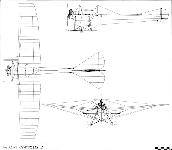C.Andrews Vickers Aircraft since 1908 (Putnam)
The Early Monoplanes
Vickers, Sons and Maxim presented a strong case to the Admiralty on 3 January, 1911, offering to supply one Pelterie-type monoplane for ? 1,500. They stressed the point that the framework of the proposed machine, except the wings, was of steel, with a possible substitution of duralumin in later models. In reply, the Admiralty expressed disinterest, and consequently no order materialised. This approach was of some historical significance, for it presaged the adherence of Vickers to advanced structural philosophies and to metal construction in particular. At that time there were few metal aeroplanes.
The metal-tube airframe was indeed the only outstanding characteristic of the early Vickers monoplanes. Beyond the fact that they were quite strong for the performance then prevailing, they had little else to commend them. They were heavy for the limited power of the standard R.E.P. engine, and attempts were made to improve their power/weight ratio by using Gnome or other engines of greater power. The small margin between flying and stalling speeds made them tricky to fly, especially with the lack of power and the absence of inherent stability, the problems of which had still to be solved at that time.
Those were the pioneering days. The hardy aviators who took to the air in flying machines had perforce to learn the hard way. The Vickers monoplanes, with their steel-tube fuselages, were capable of absorbing rougher usage than contemporary wooden aircraft. With their rigid airframes they were also more easily transported, whereas wooden aircraft were easily damaged in transit.
No. 1 monoplane was part Pelterie (rear fuselage), but the rest was of Vickers construction. Comparing the standard R.E.P with Vickers' first effort, various small modifications appear to have been made. One of the difficulties encountered in building French aircraft under licence was the conversion of metric mensuration into feet and inches, consequently most of the original drawings had to be redrawn to British practice, although it is true that certain constructors, like Bristol and Martin-Handasyde, adopted the metric system throughout their original designs.
The first monoplane was built in the Erith works of Vickers, Sons and Maxim and not at Barrow-in-Furness as was suggested in the proposals to the Admiralty. H. F. Field was works foreman in charge, and he controlled a small number of workers detailed from general engineering jobs and having no previous experience in aircraft construction. This was a situation that was to reappear later on a much greater scale in aeronautical history, especially in the two world wars.
Capt Herbert F. Wood, who had been appointed manager of Vickers' aviation department on 28 March, 1911, made the first flight from a new private aerodrome established by Vickers at Joyce Green, near Dartford, Kent, and adjacent to the Long Reach Tavern by the River Thames. All Vickers' experimental test flying was made from this site right up to the Vimy Commercial of 1919. However, soon after this first flight in July 1911, the No. 1 monoplane was taken to Brooklands and flown there.
Early in 1912 the Vickers Flying School was established at Brooklands in sheds near the Byfleet banking, where later the final erecting shops of Hawker Aircraft Ltd were situated. After the successful trials of No. 1 monoplane, more were developed from the basic design and gave good service in the Vickers School as instructional machines.
No. 1 was written off in a crash.
Monoplanes Nos. 1-7
Nos 1, 2 and 3
Accommodation: Pilot and passenger
Engine: 60 hp R.E.P.*
Span: 47 ft 6 in
Length: 36 ft 5 in
Wing Area: 290 sq ft
Empty Weight: 1,000 lb
Gross Weight: -
Max Speed
at Ground Level: 56 mph
Range: -
* Changed to 60 hp Vickers-REP on No. 2.
Показать полностью
M.Goodall, A.Tagg British Aircraft before the Great War (Schiffer)
Deleted by request of (c)Schiffer Publishing
VICKERS AIRCRAFT (Vickers House, Broadway, Westminster, London SW, with works at Erith, Crayford and Bexleyheath. Flying at Joyce Green, Dartford and Brooklands)
This company became interested in aircraft manufacture in 1911, and formed a small drawing office at Vickers House, and a section of the works at Erith for manufacture. In 1912 a flying school was established at Brooklands, which continued to operate up to the outbreak of war. Captain Wood was in charge of the Aviation Department, A.R. Low was the first draughtsman and G.H. Challenger, an engineer from Bristols; they were joined later by Howard Flanders when his company collapsed.
The first move was to acquire a license on 1 January 1911, from Robert Esnault-Pelterie (REP), to build his monoplane types, and to purchase one complete monoplane and a rear fuselage structure from France. The fuselage was incorporated into a machine, which became Vickers No.l monoplane.
VICKERS No.l monoplane
The Vickers No.l monoplane was built at Erith and tested at Vickers new airfield at Joyce Green, Dartford by Capt. H.F. Wood in July 1911, and was then taken to Brooklands, where it was reflown by Lt. H.E. Watkins. Within a few days it was packed and shipped to Australia, for use by Dr. Mawson's Antarctic Expedition, for which Watkins was to be the pilot. Unfortunately the aircraft crashed at Adelaide and, although the fuselage was taken to the Antarctic to use as a sledge, difficulties arose which prevented its use. The remains of the fuselage survived in the Antarctic for many years.
This first Vickers monoplane was a tandem two-seater, with the crew positioned between the spars of the shoulder mounted wing. The front fuselage was rectangular in section with a triangular section below, and all covered with aluminum sheet. Aft of the pilot's seat the section became diamond shaped, and was constructed of steel tube sweated at the joints into welded steel fittings, and the whole was covered with fabric.
The tapered wing was built on steel tubular spars with wooden ribs and incorporated warping for lateral control. The wing was braced to a tripod pylon, and to the bottom member of the fuselage, with high tensile steel tapes. The warping was actuated through a separate mast by cables and tapes. The tailplane and fin extended well forward to fair into the fuselage. The divided elevator was unbalanced; the rudder had a small balance area forward of the hinge post. The undercarriage was constructed of steel tube with twin wooden skids, mounting two pairs of wheels on separate axles. Shock absorption was by means of rubber cords incorporated into guides on the fuselage sides, to which the landing loads were taken by the main chassis struts, the radius arms being free to pivot from the bottom fuselage members.
Power: 60hp REP five-cylinder air-cooled semi-radial driving a 7ft 11 in diameter Regy Freres propeller.
Data
Span 47ft 6in
Chord 8ft 2in to 5ft 2in
Area 290 sq. ft
Area tailplane 54 sq. ft
Area elevators 16 sq. ft
Area fin 11 sq. ft
Area rudder 9 sq. ft
Weight 1,000 lb.
Speed 56 mph
Показать полностью
P.Lewis British Aircraft 1809-1914 (Putnam)
Vickers Monoplanes Nos. 1 to 8
An interest in the possibilities of business in aviation had been aroused in the armament manufacturers Vickers, Sons and Maxim following their experience of building the Royal Navy's first rigid airship, the R.1. The airship was a failure, but a strong belief in the heavier-than-air machine sent Capt. Herbert F. Wood, late of the 12th Lancers and the holder of the early Royal Aero Club Aviator's Certificate No. 37, to France to investigate the R.E.P. Monoplane built by Robert Esnault Pelterie. In consequence of Capt. Wood's appraisal and approval of the machine, and the further recommendation by Capt. Murray F. Sueter, R.N., who had acted as the Admiralty overseer at Barrow-in-Furness while the R.l was being built, Vickers negotiated the manufacturing rights of the design for the United Kingdom and the British Colonies.
At that time the R.E.P. Monoplane could be considered an advanced design by virtue of its steel-tubing airframe and its patented control system, which comprised a single control-column for the elevators and the wing-warping, and pedals or a bar to operate the rudder.
The first Vickers aeroplane, designated No. 1, was built early in 1911 at the Vickers works at Erith in Kent, the design work being carried out by A. R. Low and G. H. Challenger and the construction by a small, relatively inexperienced team supervised by H. F. Field. The machine followed closely the original French lay-out, using the rear part of the R.E.P., which was combined with a redesigned front fuselage and undercarriage. The engine fitted was the five-cylinder fan-shaped 60 h.p. R.E.P. radial with a 7 ft. 11 ins. diameter propeller, and this power unit, either British- or French-built, was used also on the succeeding Monoplanes Nos. 2, 3, 4 and 5, although other engines were tried experimentally.
Capt. Wood, who had been appointed Manager of Vickers Aviation Department, flew the Monoplane No. 1 for the first time in July, 1911, from a new private aerodrome which had been laid out below the level of the River Thames near the Long Reach Tavern at Joyce Green, Dartford, Kent. The machine was bought by Dr. Douglas Mawson for the use of the 1912 Australian Antarctic Expedition and was shipped to Australia. On arrival there, it was tested by Lt. H. E. Watkins, who crashed it at Adelaide. The fuselage was taken to Cape Denison, Antarctica, where an unsuccessful attempt was made to use it as a propeller-driven sledge, and the remains of the abandoned steel-tubing fuselage are said to survive there still.
<...>
SPECIFICATION (No. 1)
Description: Two-seat tractor monoplane. Steel tubing structure, fabric covered.
Manufacturers: Vickers, Sons and Maxim Ltd., Erith, Kent.
Power Plant: 60 h.p. R.E.P.
Dimensions: Span, 47 ft. 6 ins. Length, 36 ft. 5 ins. Wing area, 290 sq. ft.
Weights: Empty, 1,000 lb.
Performance: Maximum speed, 56 m.p.h.
Показать полностью
Журнал Flight
Flight, July 29, 1911.
BRITISH NOTES OF THE WEEK.
The South Pole Monoplane.
THE monoplane of the R.E.P. type built by Messrs. Vickers, Ltd., at Crayford, for Dr. Mawson's South Pole Expedition, having been completed, the initial tests were successfully carried out the other day on the firm's flying ground at Long Reach, Dartford, Brooklands being the scene of further trials.
Flight, August 26, 1911.
THE VICKERS MONOPLANE.
IT is only typical of the unerring foresight that Messrs. Vickers exhibit in all their new undertakings that they should have turned some of their vast energy to aeroplane construction, and further that, in doing so, should commence work on such a successful and well developed machine as the R. E. P. monoplane.
The experience of such a pioneer as Robert Esnault-Pelterie counts for a good deal under any circumstances, but coupled with the unique facilities for the commercial manufacture of aircraft that Messrs. Vickers possess, it means that the firm has but to get its organisation established for this department to be a success forthwith.
In this also, however, they are happily situated in having such able services as those of Captain Wood and Mr. Archibald Low, M.A., to assist them in their new departure.
Timber is very little used in the construction of the Vickers monoplane, in fact it only appears in three places, the rear skid, the two main skids, and the wings. The wings are going to have metal booms, and there is little doubt that, in these times of rapid advancement, all these parts will be fashioned from steel, much in the same way as in motor car construction the wooden chassis frame, even though armoured with metal, had soon to give way to the neat and homogeneous steel stamping.
The body framework is built up of steel tubing, cross-braced with piano wire, and, covered with fabric, possesses excellent streamline form.
The 60-h.p. R.E.P. motor protrudes from the front of the fuselage, and from its mounting bracket the body rapidly deepens, and assumes its maximum cross-section in the neighbourhood of the pilot's seat.
This deep body is an excellent point, as not only does it form a good directive keel but it enables the wing trusses and warp-operating cables to be carried to its lower longidudinal member and not as in most other machines to a portion of the chassis, a part that is always liable to serious derangement.
The Vickers landing carriage, at first sight, is strongly reminiscent of Henry Farman practice, but on closer inspection it will be observed that the shorter chassis struts are pivoted to the bottom boom of the body and that the longer struts are connected to collars that slide up and down the steel fuselage columns against the tension of strong cotton covered rubber cord.
By this means the undercarriage is endowed with a double amount of flexibility - that of the Farman and R.E.P. combined - while it has the advantage of being very little heavier than the former and certainly much lighter than the latter. It is flexible enough to enable the pilot to negotiate ploughed land with comparative comfort, and also, which is very important, it has a good wide track to prevent the machine canting over on to its wing tips.
The wings are of wood and steel construction and taper from the body to the tips. They are particularly efficient, being of a modified Phillips cross-section, as they have not the slightest difficulty in lifting this machine, in which the cutting down of weight has been ignored in favour of solid strength.
The way in which the wing trusses are fastened to the main booms and also to the fuselage is interesting, and it is refreshing to find another constructor who is not content to trust the life of the aviator to a 4 mm. bolt. The wing truss, which is formed of two strips of high tension steel wrapped together by tape, is butted into a conical ferrule, which is attached to the steel lugs of the boom clip in the manner illustrated. The tail surface is purely directional and supports no weight, thus the longitudinal stability of the machine is rendered more automatic and the pilot, by being placed further forward, has a better view of his surroundings than he otherwise would have.
Two approximately semi-circular planes rock on ball-bearings at the rear edge of the horizontal tail, and serve as elevators. The rudder, too, is swung on ball-bearings, and the whole of the tail is protected from contact with the ground by a small wooden skid.
Elevation and depression is effected by a backward and forward motion of a lever situated between the pilot's knees, and balance is maintained by rocking it laterally.
The lateral motion of the lever is transmitted to the warping-crank under the body framework by means of a crank and tubular steel connecting-rod. The rudder control is by the customary pivoted foot-lever.
The motor is a 5-cyl. 60-h.p. R.E.P. of the latest type, and a direct coupled Regy Freres tractor-screw transforms the rotary motion of the crank-shaft into effective thrust. Petrol is carried in a large tank under the passenger's seat, whence it is fed by pressure to a smaller tank placed above and behind the engine; the final feed to the carburettor is thus by gravity.
Показать полностью













